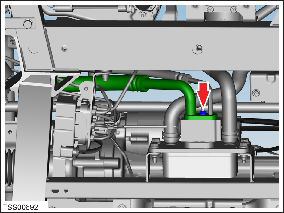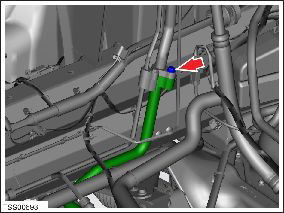Tesla Model S: Pipe - Low Pressure - Chiller (Remove and Replace)
Tesla Model S (2012-2025) Service Manual / Thermal Management / Pipe - Low Pressure - Chiller (Remove and Replace)
Removal
- Recover refrigerant from the vehicle (refer to procedure)
- Remove front skid plate (refer to procedure)
- Remove nut (x1) securing pipe retaining plate to chiller TXV
(torque 12 Nm).

- Disconnect refrigerant pipes from TXV. Caution: Plug pipe connections to prevent ingress of moisture or dirt. Caution: Remove and discard O-rings.
- Remove underhood storage unit (refer to procedure)
- Remove bolt securing chiller low pressure pipe at union to low
pressure charge port pipe (torque 8 Nm).

- Maneuver and remove pipe.
Caution: Plug pipe connections to prevent ingress of moisture or dirt.
Caution: Remove and discard O-rings.
Installation- Installation procedure is the reverse of removal, except for the following:
- Replace A/C pipe O-rings.
Caution: Lubricate new O-rings with clean refrigerant oil.
READ NEXT:
 TXV Valve - Evaporator (Remove and Replace)
TXV Valve - Evaporator (Remove and Replace)
Removal
Recover refrigerant from the vehicle (refer to procedure)
Remove underhood storage unit (refer to procedure)
Remove nut securing pipe retaining plate to evaporator TXV
(to
 TXV Valve - Chiller (Remove and Replace)
TXV Valve - Chiller (Remove and Replace)
Removal
Recover refrigerant from the vehicle (refer to procedure).
Remove the front skid plate (refer to procedure).
Remove the nut that secures the pipe retaining plate to the TXV
 Pressure Transducer - Low Pressure (Remove and Replace)
Pressure Transducer - Low Pressure (Remove and Replace)
Removal
Recover refrigerant from the vehicle (refer to procedure).
Remove the underhood storage unit (refer to procedure).
Disconnect the electrical connector from the pressure
tr
SEE MORE:
 Subframe Assembly - Front (Remove and Install)
Subframe Assembly - Front (Remove and Install)
Special tools required for this procedure:
Supplier
Part Number
Description
Tesla
1021241-00-B
Subframe
Fixture, Rear, MDLS
 Forward Junction Box - 2nd Generation - 20 Amp Fuse (RWD) (Remove and
Replace)
Forward Junction Box - 2nd Generation - 20 Amp Fuse (RWD) (Remove and
Replace)
Warning: Only technicians who have been trained in High
Voltage Awareness are permitted to perform this procedure. Proper
personal protective equipment (PPE) and insulating HV gloves with a
minimum rating of class 00 (500V) must be worn any time a high
voltage cable is handled. Refer
© 2019-2025 Copyright www.tesms.org

